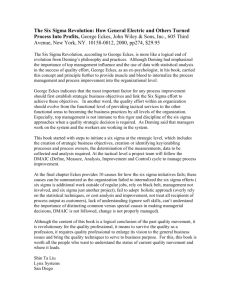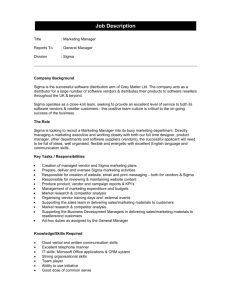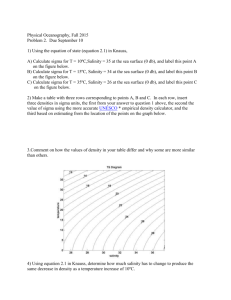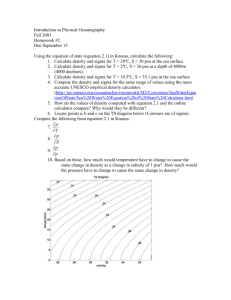Six Sigma = self service success
advertisement
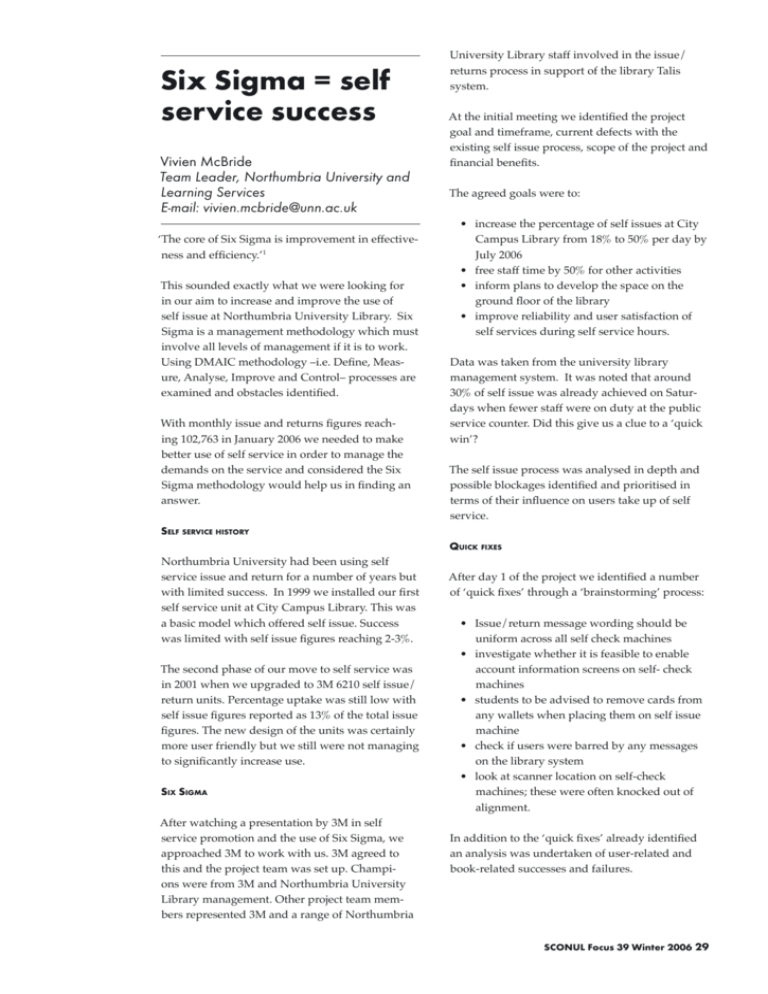
Six Sigma = self service success Vivien McBride Team Leader, Northumbria University and Learning Services E-mail: vivien.mcbride@unn.ac.uk ‘The core of Six Sigma is improvement in effectiveness and efficiency.’1 This sounded exactly what we were looking for in our aim to increase and improve the use of self issue at Northumbria University Library. Six Sigma is a management methodology which must involve all levels of management if it is to work. Using DMAIC methodology –i.e. Define, Measure, Analyse, Improve and Control– processes are examined and obstacles identified. With monthly issue and returns figures reaching 102,763 in January 2006 we needed to make better use of self service in order to manage the demands on the service and considered the Six Sigma methodology would help us in finding an answer. University Library staff involved in the issue/ returns process in support of the library Talis system. At the initial meeting we identified the project goal and timeframe, current defects with the existing self issue process, scope of the project and financial benefits. The agreed goals were to: • increase the percentage of self issues at City Campus Library from 18% to 50% per day by July 2006 • free staff time by 50% for other activities • inform plans to develop the space on the ground floor of the library • improve reliability and user satisfaction of self services during self service hours. Data was taken from the university library management system. It was noted that around 30% of self issue was already achieved on Saturdays when fewer staff were on duty at the public service counter. Did this give us a clue to a ‘quick win’? The self issue process was analysed in depth and possible blockages identified and prioritised in terms of their influence on users take up of self service. Self service history Quick fixes Northumbria University had been using self service issue and return for a number of years but with limited success. In 1999 we installed our first self service unit at City Campus Library. This was a basic model which offered self issue. Success was limited with self issue figures reaching 2-3%. The second phase of our move to self service was in 2001 when we upgraded to 3M 6210 self issue/ return units. Percentage uptake was still low with self issue figures reported as 13% of the total issue figures. The new design of the units was certainly more user friendly but we still were not managing to significantly increase use. Six Sigma After watching a presentation by 3M in self service promotion and the use of Six Sigma, we approached 3M to work with us. 3M agreed to this and the project team was set up. Champions were from 3M and Northumbria University Library management. Other project team members represented 3M and a range of Northumbria After day 1 of the project we identified a number of ‘quick fixes’ through a ‘brainstorming’ process: • Issue/return message wording should be uniform across all self check machines • investigate whether it is feasible to enable account information screens on self- check machines • students to be advised to remove cards from any wallets when placing them on self issue machine • check if users were barred by any messages on the library system • look at scanner location on self-check machines; these were often knocked out of alignment. In addition to the ‘quick fixes’ already identified an analysis was undertaken of user-related and book-related successes and failures. SCONUL Focus 39 Winter 2006 29 Library users A survey of library user activities was conducted by library staff with guidance, at the start, from 3M staff. Over three weeks staff observed how library users used the self-check machines and recorded problems they encountered. • • • • to pay fines to collect reservations check loan status self issue would not satisfy issuing client (i.e. the user requires something other than issue, return or renewal). User behaviour The differences between client-related and bookrelated problems were noted. The main client-related problems were: • user friendliness of the units - users had to select between ‘check out’ and ‘check in’: this resulted in delays as user selected their option • card handling - library users often got confused about how to position the smartcard correctly and often removed the smartcard before it had been successfully scanned • book handling - barcode labels, particularly on older books, had caused some problems; we had been re-barcoding but we still had a large number which could not be read by the scanners or were in the wrong position • PIN not known - we had decided to use PINs to ensure an element of security, and although PINs were issued to new students at registration many did not remember them • over loan limit - our loan limit for undergraduate students is 10 and 15 for undergraduate and final year students, which was quickly reached by undergraduate students. The main book-related problems included: • bad barcode - as with the client-related problems bad barcodes prevented self issues and returns; users became frustrated when scanning a pile of books only to find that the last item wouldn’t scan and they had to go to the circulation desk to have their item issued • item reservation - users who found reserved items on the shelves were similarly frustrated when they were stopped from borrowing an item which had a reservation against it • reference only book - although labelled for reference use only students optimistically tried to borrow these via the self service units. We compared these problems with reasons why library users were going to the issue desk to have books issued in preference to using self service machines. They were mainly: 30 SCONUL Focus 39 Winter 2006 Other points observed: • it was noted that whilst we had ‘dual function’ machines, to allow issue and return of books in one transaction, most users in fact used only one function, as the switch between issue/return was cumbersome and caused confusion and delays • given the choice between the staffed issue/ returns desk and a machine many users automatically selected the staffed service; this was in fact seen as one of the largest blocks to increasing take up of self service. Actions taken For the next two months we addressed the problems identified by the surveys with the following actions. • meeters and greeters were available to help students use the self-check machines, demonstrate how to select the issue or return function, place the smartcard and book on the unit, enter the PIN and obtain a receipt, helping to overcome the previous negative experiences of users • the number of staff at the issue desk was reduced and instead staff were timetabled to assist with self service: an average of 224 weekday hours was spent on the counter; the goal was to reduce staff time on issuing by 50% • a campaign was run to promote use of PINs: we sent e-mails reminding students of their PIN, displayed notices and flyers around the university, and put details of how to get a PIN –and why it was needed– on the library plasma screens and web pages • the fines limit was raised: when the limit of £3.00 outstanding fines was reached users were prevented from using self issue; we raised this to £10.00 • signage was changed: we removed the word ‘self’ so that the signs referred to ‘issue’ and ‘return’ • the queuing system changed direction to face the self service units • for one week we offered spot prizes of book tokens to users of the self-check machines • we analysed statistics and reviewed the self check capacity to ensure the existing units could handle the potential throughput • we trialled using trolleys for returned items instead of book bins: this did not prove to be very successful as the trolleys quickly filled as books were placed at random on the trolleys • we promoted the Key Text Collection where core text books were available on a self service issue/return basis (in the Key Text Collection we were piloting the new 3M V series of self-check machine with RFID tags). decisions regarding the future of our loans service and overall building design. The outcomes of the project and the changes it informed have led to a successful major shift in service delivery in a period of five months. Our thanks go to 3M and library staff in their considerable input into a successful project. References 1 G. Eckes, The six sigma revolution: how General Electric and others turned process in, New York; Chichester : John Wiley, 2001 Bibliography By applying all these actions identified by the Six Sigma Project we were able to see a significant increase in the number of self issues with a rise to 50%. However, it also became clear that using existing technology, current layouts and with the problems of unreadable book barcodes, usage of self service was unlikely to increase beyond this. Further development of our self service model required new solutions, and the outcomes of Six Sigma project were used to inform a number of major library developments. G. Eckes, Making Six Sigma last: managing the balance between cultural and technical, New York : John Wiley, 2001 Firstly, we had to decide whether to retain existing barcode technology and re-barcode stock or migrate to RFID utilising more efficient technology with added value functions available. Following the successful pilot in our Key Text Collection we agreed to proceed with RFID and to replace our old issue/returns machines with the new 3M V series. Secondly, an opportunity arose to refurbish our ground floor entrance area and rearrange our services. A new welcome desk was created (see Annie Kilner’s article in this issue of SCONUL Focus) and the issue/returns area rearranged in the light of Six Sigma outcomes, to give prominence to self service as the primary mode of operation, separate self issue and return functions, and allow better queue management. The result in October 2006 was a rise to 82% self issue. Conclusion Six Sigma in itself gave us few new ‘revelations’ as to why self service wasn’t being used. Many of the problems identified we were already aware of ourselves. However, it did concentrate the mind in looking at these systematically, targeting issues which could be resolved quickly and giving us a more informed basis for some strategic policy SCONUL Focus 39 Winter 2006 31


